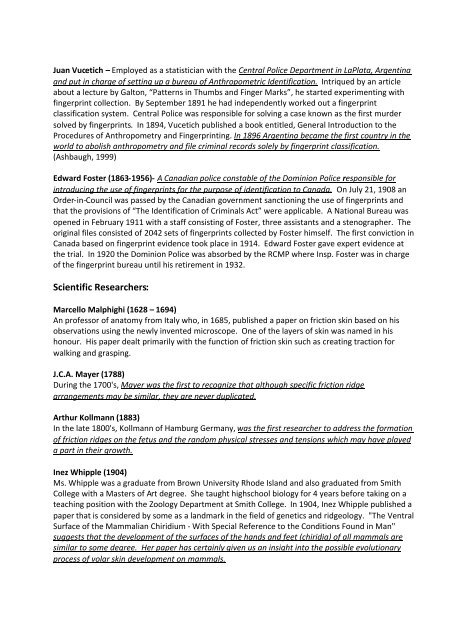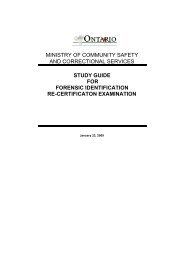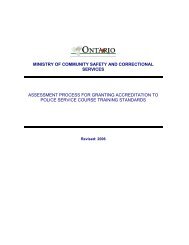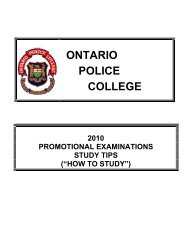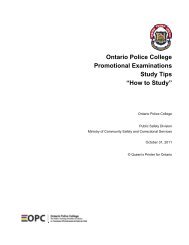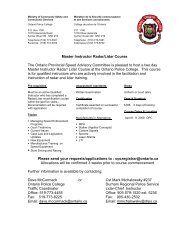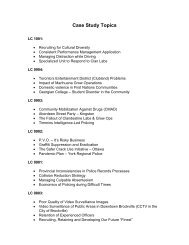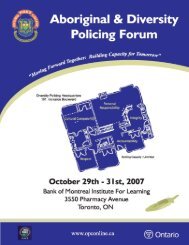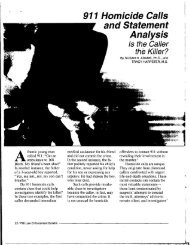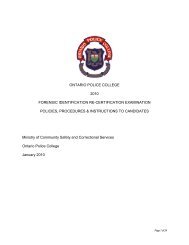General Study Guide - Ontario Police College
General Study Guide - Ontario Police College
General Study Guide - Ontario Police College
You also want an ePaper? Increase the reach of your titles
YUMPU automatically turns print PDFs into web optimized ePapers that Google loves.
Juan Vucetich – Employed as a statistician with the Central <strong>Police</strong> Department in LaPlata, Argentina<br />
and put in charge of setting up a bureau of Anthropometric Identification. Intriqued by an article<br />
about a lecture by Galton, “Patterns in Thumbs and Finger Marks”, he started experimenting with<br />
fingerprint collection. By September 1891 he had independently worked out a fingerprint<br />
classification system. Central <strong>Police</strong> was responsible for solving a case known as the first murder<br />
solved by fingerprints. In 1894, Vucetich published a book entitled, <strong>General</strong> Introduction to the<br />
Procedures of Anthropometry and Fingerprinting. In 1896 Argentina became the first country in the<br />
world to abolish anthropometry and file criminal records solely by fingerprint classification.<br />
(Ashbaugh, 1999)<br />
Edward Foster (1863-1956)- A Canadian police constable of the Dominion <strong>Police</strong> responsible for<br />
introducing the use of fingerprints for the purpose of identification to Canada. On July 21, 1908 an<br />
Order-in-Council was passed by the Canadian government sanctioning the use of fingerprints and<br />
that the provisions of “The Identification of Criminals Act” were applicable. A National Bureau was<br />
opened in February 1911 with a staff consisting of Foster, three assistants and a stenographer. The<br />
original files consisted of 2042 sets of fingerprints collected by Foster himself. The first conviction in<br />
Canada based on fingerprint evidence took place in 1914. Edward Foster gave expert evidence at<br />
the trial. In 1920 the Dominion <strong>Police</strong> was absorbed by the RCMP where Insp. Foster was in charge<br />
of the fingerprint bureau until his retirement in 1932.<br />
Scientific Researchers:<br />
Marcello Malphighi (1628 – 1694)<br />
An professor of anatomy from Italy who, in 1685, published a paper on friction skin based on his<br />
observations using the newly invented microscope. One of the layers of skin was named in his<br />
honour. His paper dealt primarily with the function of friction skin such as creating traction for<br />
walking and grasping.<br />
J.C.A. Mayer (1788)<br />
During the 1700's, Mayer was the first to recognize that although specific friction ridge<br />
arrangements may be similar, they are never duplicated.<br />
Arthur Kollmann (1883)<br />
In the late 1800's, Kollmann of Hamburg Germany, was the first researcher to address the formation<br />
of friction ridges on the fetus and the random physical stresses and tensions which may have played<br />
a part in their growth.<br />
Inez Whipple (1904)<br />
Ms. Whipple was a graduate from Brown University Rhode Island and also graduated from Smith<br />
<strong>College</strong> with a Masters of Art degree. She taught highschool biology for 4 years before taking on a<br />
teaching position with the Zoology Department at Smith <strong>College</strong>. In 1904, Inez Whipple published a<br />
paper that is considered by some as a landmark in the field of genetics and ridgeology. "The Ventral<br />
Surface of the Mammalian Chiridium - With Special Reference to the Conditions Found in Man"<br />
suggests that the development of the surfaces of the hands and feet (chiridia) of all mammals are<br />
similar to some degree. Her paper has certainly given us an insight into the possible evolutionary<br />
process of volar skin development on mammals.


